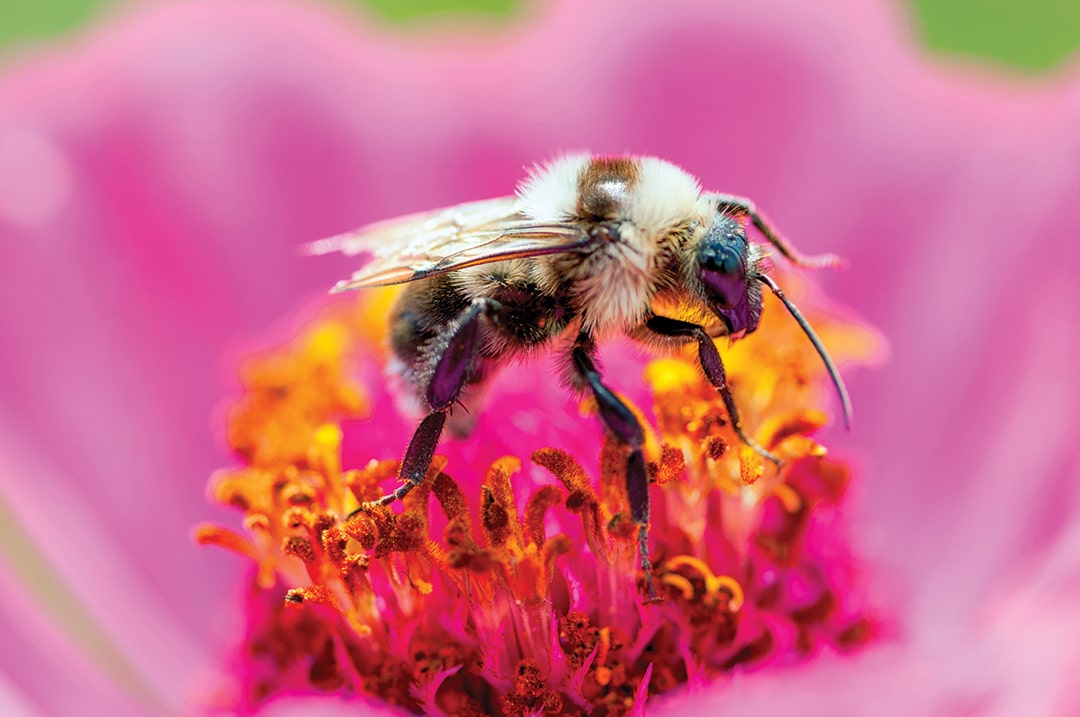To celebrate the harvest season and the bounty of food served on Thanksgiving tables across the nation, thanks in part to pollinators, Bayer is expanding its Feed a Bee program and continuing to promote pollinator health. As such, the company has teamed up with The Wildlife Society (TWS) and embarked on a six-week tour to plant additional pollinator forage at four locations.
Announced at TWS’ annual conference in Raleigh, North Carolina, Oct. 15-19, approximately 50 million wildflower seeds will be planted at strategic locations in Texas, Kansas, Illinois and Florida, where TWS has a robust regional presence.
“The Feed a Bee program is tackling a really important need for pollinators by conducting plantings across the nation this fall,” says Ken Williams, TWS CEO. “At TWS, dedicated chapter members in each region are working now to identify the optimum mix of wildflower seeds to plant in each location to ensure pollinators have access to a wide variety of diverse nutrition sources when bloom occurs in the spring.”
The original goal established for the Feed a Bee program this year was to generate enough social actions through a Twitter campaign to plant 25 million pollinator-attractant wildflower seeds. Each share of the bee emoji and #FeedABee online triggered additional, real wildflower seeds being tallied for the fall plantings, according to Bayer. The campaign beat expectations and will result in the planting of 50 million wildflower seeds total.
Existing Feed a Bee partners will plant native wildflowers this fall, including:
- Texas Tech University Department of Plant and Soil Science in Lubbock, Texas.
- McCarty Family Farms in Scott City, Kansas.
- Salem4youth in Flanagan, Illinois.
- The Packers of Indian River in Fort Pierce, Florida.
The pollinator tour kicked off in October in Lubbock, Texas, where the Texas Tech University (TTU) Department of Plant and Soil Science hosted an educational pollinator field day that highlighted new native bee and habitat research being conducted by graduate students. Attendees, including local growers, TTU students and representatives from the U.S. Department of Agriculture’s Natural Resource Conservation Service also helped establish new forage areas for pollinators at the Quaker Avenue Research Farm, the 130-acre farm operated by the department.
“Pollinators, including native bees, honeybees and more, play an important role in agriculture and our ecosystem as a whole,” says Scott Longing, assistant professor of entomology at TTU and member of the Texas Chapter of TWS. “By continuing to research ways to combat the challenges they face and planting additional forage in the meantime, we can help promote and protect pollinator health in a variety of ways.”
According to Longing, pollinators’ contributions to crop yields and threats to biodiversity on the highly fragmented southern high plains have been dramatically understudied.
“From a better understanding of the associations of habitat resources, landscapes and agricultural practices, we hope to assist producers in sustaining pollination services in crops, while developing information to support the conservation of broader pollinator biodiversity in the region,” he says.
Following the field day, Feed a Bee visited the Carolyn Lanier Youth Farm for a special program with the South Plains Food Bank’s Growing Recruits for Urban Business (GRUB) Program, which teaches young adults how to plant, grow, maintain, harvest and market their own produce, while also providing classes on nutrition and healthy living. The students were able to view a working hive up close before getting their hands dirty and planting additional forage next to their garden plots.
“Every Saturday, our students learn more about all the hard work that goes into growing fruits and vegetables, but the Feed a Bee event helped them understand the role of the hardest workers of all, pollinators,” shares Lynn Weir, director of Farm, Orchard and GRUB Division for the South Plains Food Bank.
The remaining plantings will take place throughout November and December and promise to engage with even more partner organizations and communities to celebrate pollinators and establish additional forage.
“Every additional bit of forage planted helps pollinators, whether it’s next to a community garden, alongside cropland or in a homeowner’s backyard,” adds Becky Langer, project manager for the North American Bayer Bee Care Program.
Feed a Bee is a national initiative to plant more wildflowers for pollinators and educate a broader audience about the importance of pollinator health. By enlisting the help of more than 500,000 individuals and more than 115 partner organizations, Feed a Bee has planted more than 155 million pollinator-attractant flowers to date. Individuals can get involved by visiting FeedABee.com to pledge to plant their own pollinator patches and learn more about other ways to get involved throughout the year.










